In India, more than any other place on earth, the natural and spiritual worlds conjoin. Air and light, trees and mountains, animals and fire are all worshiped as gods. But the most important natural deity for Hindus is the Ganges River, an embodiment of the Goddess Ganga. A water goddess, Ganga originally tended the gardens of heaven. King Bhagirath begged Lord Brahma to force Ganga to descend to Earth and purify the soul of his 60,000 ancestors, whose ashes were trapped in purgatory. Impressed by the faithfulness of Bhagirath, who had meditated for 1,000 years prior to requesting this favor, Brahma ordered Ganga down to Earth.
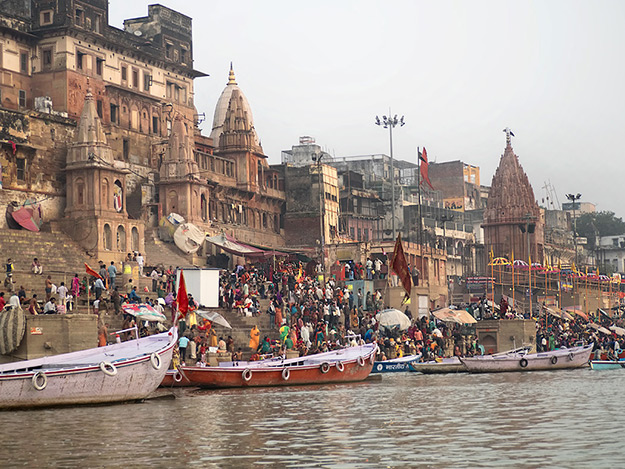
The unhappy Ganga knew she could not disobey a command from the Gods, so she agreed. Secretly, however, she planned to descend with a speed so tremendous that her waters would wash away the Earth. Fortunately, Lord Shiva intervened. He caught the falling river on his head, channeling its flow through his matted locks and separating the waters into thousands of lesser streams. The lovely legend comes to life each spring, when soaring temperatures begin to melt snow and ice in the highest reaches of India’s Himalayas. Billions of droplets form rivulets that tumble down the precipitous mountains like tangled braids. They fatten with every mile, becoming white-capped torrents that surge through valleys and canyons, pulverizing the dense gray rock.
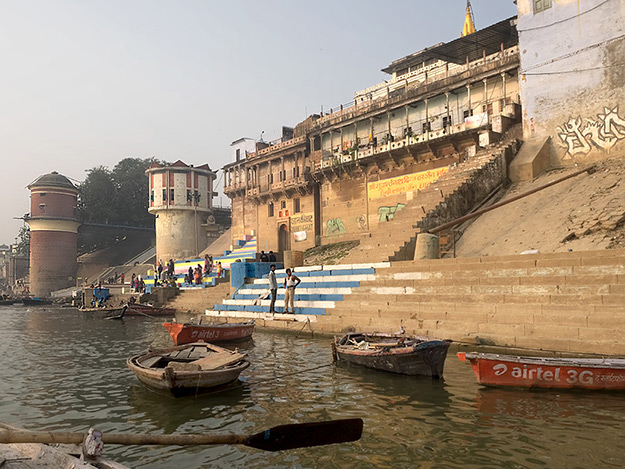
At Devprayag, in the foothills of the Himalayas, the Alaknanda and Bhagirathi Rivers merge and give birth to the Ganges. Here, the river widens and settles down for its long journey to Bangladesh, more than 1,500 miles from where those first icy drops sweated off the glacier. By the time it reaches Varanasi, the Ganges is tamer, as if capitulating to the human tide that flocks to its banks. Pilgrims believe that touching its sacred water leads to moksha – release from suffering brought on by the endless cycle of death and reincarnation. And no other city draws more devotees to the river’s shores than Varanasi, India.
On my first afternoon in this holy city, I joined throngs of worshipers at the Varanasi ghats. I began at Assi Ghat, the southernmost of the 87 steep stairways that descend to the river. I headed north, traversing one ghat after another. On my right, the mighty Ganges flowed by like liquid mud. To my left, ancient palaces provided a stunning backdrop, their turreted and crenelated sandstone facades a testament to the Mughal emperors who built them.
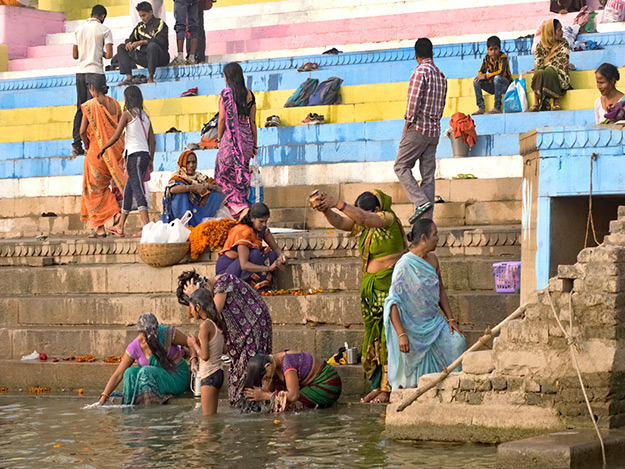
During festivals, up to 70 million worshipers congregate at the Varanasi ghats each day. Fortunately, my visit did not coincide with any of the many Hindu holidays. I only had to contend with a few thousand visitors and the ubiquitous touts. Every step of the way, vendors pushed food, drinks, and trinkets in my face. One old lady grabbed my arm and began to rub it – did I want a massage? Another mimicked scissors with two fingers – did I need a haircut? Beggars with sun-wrinkled faces extended bony arms in supplication, hoping for a Rupee or two. Nimbly, I side-stepped them all and continued on my walking tour.
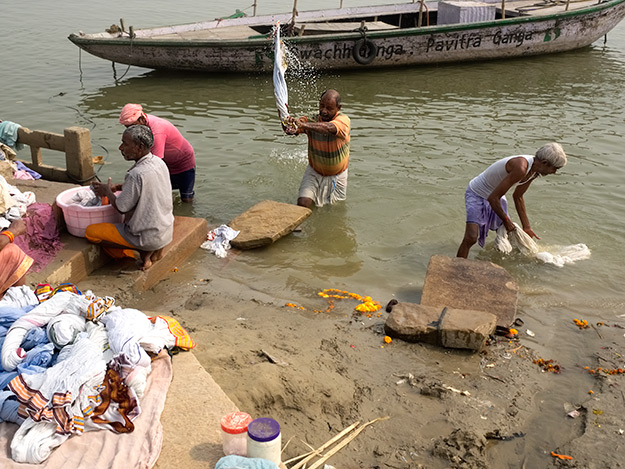
Some ghats are devoted to ritual bathing, while other ghats are reserved for doing laundry. A few are the domain of holy men who squat along the banks, offering endless prayers. At Harishchandra Ghat, cremation fires rage day and night, reducing bodies to ash and bone. I raised my camera to take a photo, but an orange-robed Sadhu with hair bound up in a ragged red turban stepped into my path. “No photos,” he announced sternly. I lowered my camera slightly and raised an eyebrow. “Earlier today mourners attacked a visitor who was taking photos and beat him severely.” I acquiesced and followed him to a viewing platform, where he explained Hindu cremation rituals.

Due to India’s intense heat, each body is prepared by family members within six to seven hours of death. It is washed, rubbed down with ghee, and anointed with fragrant oils. Female corpses are swathed in white silk, men in red, and mounds of flowers are scattered atop the shroud. The body is then carried down to the burning ghat on a bamboo rack and immersed in the river. Each family member scoops up some water and pours it into the mouth of the deceased, providing the soul with his or her last drink from the Holy Ganga. While the body is being placed on a concrete slab and covered with wood, the family fills out paperwork at town hall. After providing details about the reason and time of death, the cremation is approved. Only then does the priest ignite the funeral pyre with a flame from the adjacent Shiva Temple.

I watched the fires devour more than a dozen bodies. A pall of smoke hung over the grounds, but the acrid odor of burning flesh was notably absent. At the height of the infernos, many of the pyres collapsed, exposing skulls with hollow eye sockets and renegade limb bones. Priests re-position the bodies and bank each fire for approximately three hours, however not everything is reduced to ash. According to the Sadhu, a man’s chest will not burn because he works hard. Women’s hips survive the flames because they are strong from bearing children. These remaining bones are casually tossed into the Ganges.
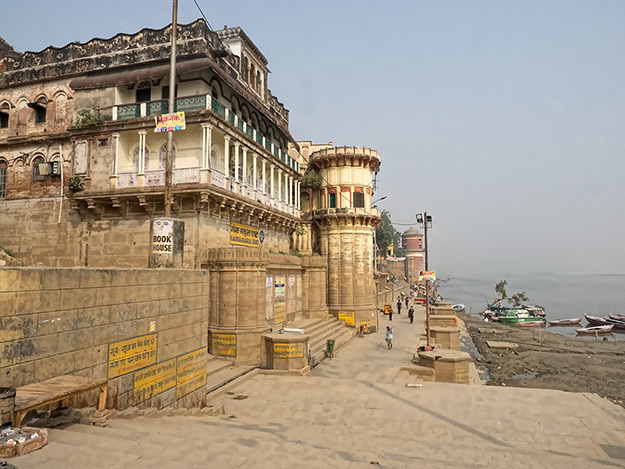
Hindus believe that a fiery dissolution of the body purifies the soul, but not every deceased Hindu is cremated. Lepers are considered to have experienced such great suffering that they are already purified. Likewise, pregnant women, children under the age of ten, and sadhus are not cremated because they are already pure. Additionally, those who die from a snakebite are considered pure because serpents are the protectors of Lord Shiva. These bodies are weighted down with rocks, ferried out into the middle of the Ganga, and tossed overboard.
Late in the afternoon, I headed back to Assi Ghat to attend the Aarti Fire Purifying Ceremony, a festival of light held each evening in honor of divine river goddess. Soon after the sun’s final orange flick sank below the horizon, six young Hindu priests stepped up to their respective platforms and faced the Ganges. In unison, they raised giant conch shells to their lips and blew. The wail instantly silenced the crowd. In a near trance state, the priests etched circles in the blue-black night with their flaming lamps, acquiring the power of the deity. Turning suddenly, they thrust the lamps toward us, transferring the blessings of Mother Ganga onto the crowd.
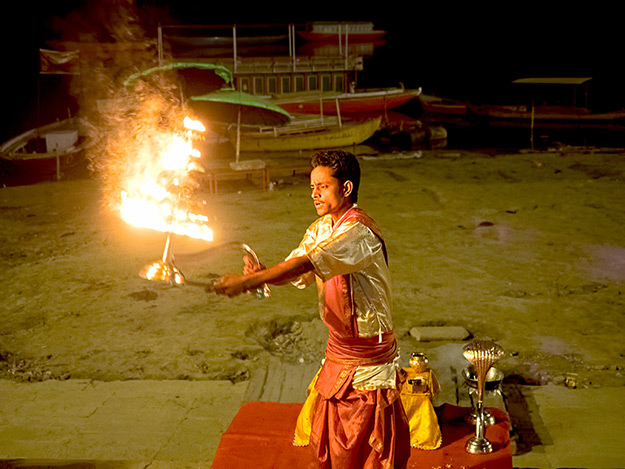
For the next few days I wandered up and down the Varanasi ghats, ducking into temples and climbing to rooftop restaurants for a birds-eye view. I got hopelessly lost in the claustrophobic alleys of the old city. I bartered with tuk-tuk drivers and jounced along disintegrating streets in bicycle rickshaws, my hips screaming with every pothole bounce. But it wasn’t until my final morning, when I clambered into a creaky old wooden boat at 5 a.m., that I experienced the true glory of Varanasi, India.
We shoved off and were soon caught by the current. For the next few minutes, the utter stillness was broken only by the sound of oars dipping rhythmically in and out of the river. A magnificent Milky Way swaggered across the moonless sky, reflecting on the mirror smooth surface of the river. I gasped when the lights of Assi Ghat came into view. Thousands of pilgrims stood hip-deep in the river. Women in rainbow saris linked arms and dunked once, twice, three times. Others filled brass urns with the holy water or sipped from water scooped into cupped hands. Many closed their eyes and stood ramrod straight, praying as the river swirled around them. Unadulterated ecstasy shone from every face. Intellectually, I had always known that Hindus consider the source of the Ganges to be a crossing point between heaven and earth. But that morning on the Ganga, in my heart, I knew it was true.
For more information on how to get to Varanasi, where to stay, and what to do in this most spiritual of India’s cities, I suggest checking out this detailed Varanasi Travel Guide by Madhurima Chakraborty, who writes from the viewpoint of an Indian national on her blog, Orange Wayfarer.

This Blog is very intersting I Read your content you written in proper in great way.
Thanks for sharing amazing information.
Your blog has piqued a lot of real interest. I can see why since you have done such a good job of making it interesting. I appreciate your efforts very much. you wrote full information of the Ganga river. Liked the blog, Keep posting.
Really loved the article, the article with complete story how river originated and todays how it is been going there. Nice one, keep sharing.
Thanks so much Pawna. Glad you enjoyed my story.
Wonderful information about varanasi, it will help us to explore more.
i visited Varanasi twice. very honestly the place is too crowded, with locals, babas, foreigners. It make us to think about history of rituals. Seeing videos, pictures just it connects me to my past visits tours at Varanasi. Good to read remind my Varanasi tour.
Hello Hanumant: Thanks for your comment. Varanasi is definitely dizzying, but for me it still exudes a deep spiritual connection that I don’t find many other places.
I have heard that it is a holy place too. Being an ancient city along with its own culture can be amazing sometimes.
Varanasi, or Benaras, (also known as Kashi). Mark Twain, the English author, and literature, who was enthralled by the legend and sanctity of Benaras, once wrote: “Benaras is older than history, older than tradition, older even than legend and looks twice as old as all of them put together. ”
Amazing shots.love to be there. thanks a lot for sharing.
Thank you Danica
Varanasi – Oldest city in India. Bank of Ganga has become cleaner in last 2 year due to swaccha Bharat abhiyan.
I’m very happy to hear that Akash.
Great point you make there. good POST. I like your perspective on this subject.
very nice Places
Hey Barbara!! Thanks for the sharing deep information about Varanasi. Though there is no plan to visit India next year. But yes, after getting information, Varanasi is in my bucket list.
If you’ve never been to India before Stella, prepare yourself for a shock. Best idea is to build in some down-time at at your resort or hotel, as India can be exhausting. But you will come away with a sense of wonderment and total gratitude. Well worth enduring the rough travel, IMHO.
I love to visit this place Varanasi. Such a spiritual place in India. Love to be here and soon.
Hope you get to visit Varanasi, Alice. It’s a truly special place.
I have been to Varanasi a few times and I must say you have written one of the most memorable articles on Varanasi that captures the essence of the city perfectly.
Thank you Prasad! Your comment made my day. Actually, that story is one of my favorites out of more than 3,000I have written, so I truly appreciate your kind comment.
It seems you explore Varanasi very well. I visited Rajasthan and Ladakh last year but missed Varanasi. I hope my next trip will be Varanasi. Thanks for sharing the deep information about Varanasi.
Hi Alina – and Rajasthan and Ladakh are both still on my travel wish list 🙂
Barbara,
I love the phrase “unadulterated ecstasy”! Your post was Intriguing and kept my attention throughout your writing. I have never had the fortune of visiting India much less the Ganges and all its luster. I definitely have moved it up my travel list after reading this post young lady! #safetravels
Mike
Thank you so much, Mike. You, nore than most, understand what a high compliment you have paid me, and I appreciate it.
Great list pict! I’d love to take one of these road trips one day. Thanks for sharing
You’re very welcome, Angeline. Hope your wish comes true.
Varanasi is a beautiful place where every buddy get the calmness.
It’s crowded, historic, and extremely spiritual, but I’m afraid I can’t say that Varanasi is particularly beautiful 🙂
Hi Barbara: Thanks so much for your wonderful verbal and visual descriptions of this area of India. I’ve been to India two times, once as a volunteer at the Nek Chand Rock Garden when I also visited the Ajanta and Ellora Caves. All three were wonderful cultural experiences. I’ve just recently returned from 18 days visiting Nagaland and the Hornbill Festival. And again another amazing, difficult, memorable visual and mind awakening experience. I’ve written this visit up and it will be published in June in the International Travel News.
All best in your upcoming visits and thank you for sharing.
Audrey Darby
Hi Audrey: Thanks so much for your kind comment. It really means a lot to me when people say they appreciate my writing and photos.
Reading your comments and watching the videos we are reliving our trip.
Beautiful work. Be safe.
Thanks so much Mark. I’ve moved on from India: Thailand, Australia, and now in the Maldives 🙂 Never any worries about safety!
Wonderful trip and great photos! Especially enjoyed the rickshaw trip through Old Delhi.
Be sure to see the Ellora caves near Aurangabad, Maharashtra. There is also a famous Shiva lingam temple there well worth seeing.
Hi Roxan: Thanks so much for your comment, and for the nice compliment. I have been to Ajanta, which are the Buddhist Caves, but not yet to Ellora. Definitely on my list, though!
What a wonderful description of the rituals and daily goings on in Varanasi. You’ve brought it alive for me. Thank you Barbara